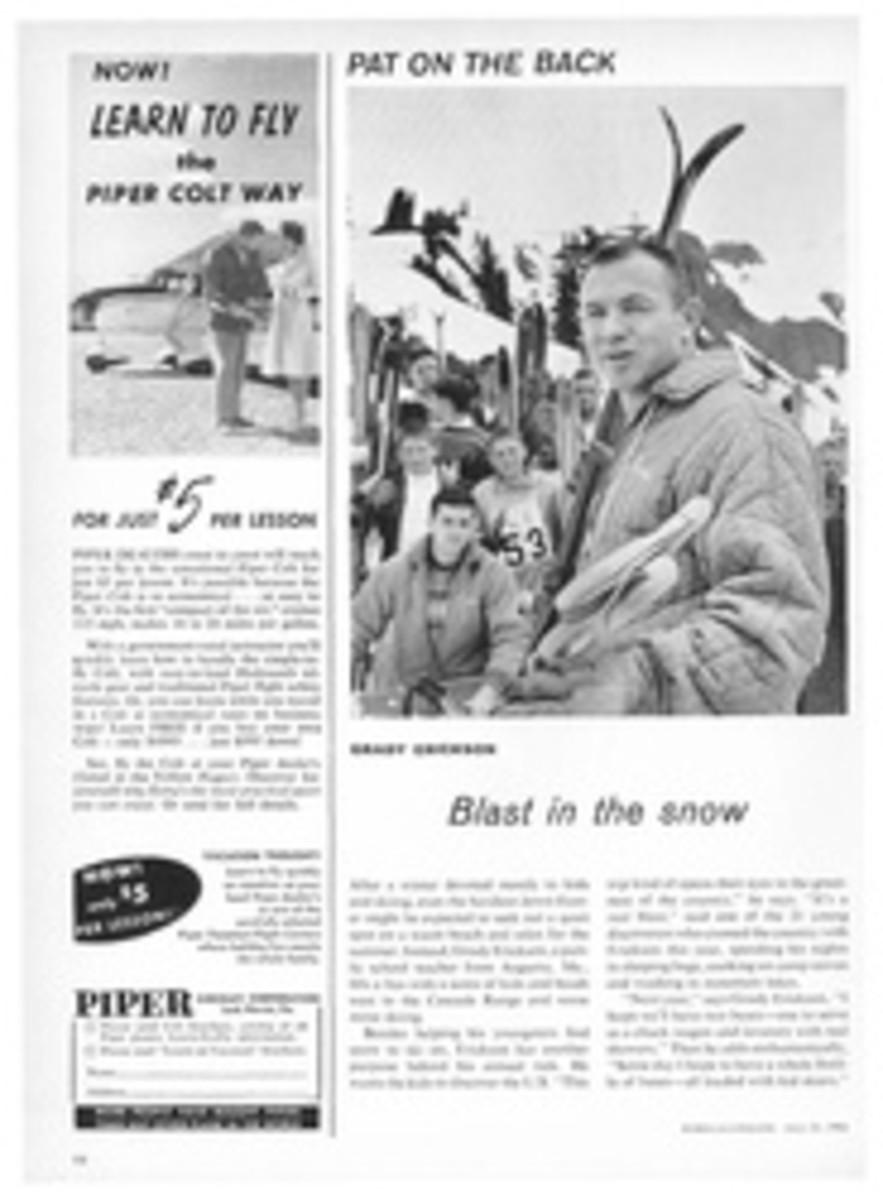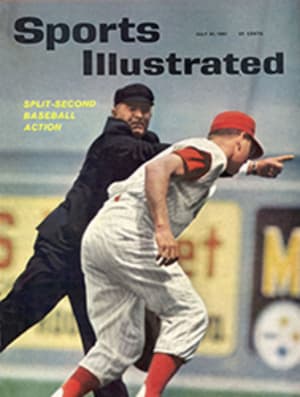
ASSAULT ON THE RECORD
Of all the records in sports, none is more honored, none more renowned than the 60 home runs Babe Ruth hit in 1927. Since then many men have seriously attacked it, but for every June challenge there has been a September reckoning. Twice men have come close. Jimmy Foxx and Hank Greenberg each hit 58 home runs, Foxx in 1932, Greenberg six years later. No one has done that well since, but last week, as the season moved into its second half, it began to look as if Ruth's record finally might fall. The challenge comes not from one man but two, Mickey Mantle and Roger Maris, teammates on the New York Yankees.
Mantle and Maris, with 37 and 36 home runs apiece, are currently running about 20 games ahead of the pace Ruth set in 1927. Mantle hit his 37th home run in the Yankees' 92nd game. Ruth did not hit his 37th until the Yankees' 114th game. Such comparisons with Ruth's pace have always been deceptive, however, since Ruth hit so many of his home runs late in the season. After 123 games of the 1927 season, Ruth had hit only 40 home runs, but in his last 32 games he hit 20, 17 of them in September. (Ruth's late surge crushed his teammate, Lou Gehrig, who was tied with Ruth 44-44 on Labor Day. Gehrig finished with 47.) Any serious challenger must go into September with a cushion.
Mantle hit his first home run this season in the Yankees' third game, and he quickly opened up an 8-1 lead over Maris, who didn't hit his first until the Yankees' 11th game. But in May Maris reduced the lead to 14-12, and in June he passed Mantle by hitting 15 home runs. Maris led Mantle by four at the All-Star break, but then Mantle rallied to take the lead. In a game at Boston last week Maris hit a home run to tie Mantle, who touched his teammate's hand in salute and then hit a home run to regain his lead. This competition between the two, even if friendly, should be beneficial to both players. Just as Roger Bannister needed Chris Chataway to help him break the four-minute mile, Maris and Mantle are an ever-present stimulus to each other.
Last year they also battled each other for the home run title (Mantle won 40-39) and at that time relations between the two became cool. Mantle was the incumbent hero, a Yankee star for nine years. Maris was the new boy, brought to New York in a trade with Kansas City, and he stole much of Mantle's glory with his early-season hitting. Both men are brooders and inclined to sulk. They were outwardly cordial to each other, but it was not an easy relationship. This season they have apparently learned the secret of peaceful coexistence.
The duel between the two Yankee sluggers has drawn capacity crowds during the team's latest road trip. In Chicago, Baltimore (where both players lost home runs in a rained-out game), Washington and Boston, the cheers for Mantle and Maris matched those usually reserved for the home-town heroes. The New York newspapers have devoted their blackest print to the home run battle, MICK 37, ROG 36 one headline read last week. When Tony Kubek hit a single to drive home the winning run in extra innings, a headline reported YANKS WIN, MARIS (35) SAVES GAME. A few days later John Blanchard pinch-hit a grand-slam home run with two out in the ninth inning to turn defeat into victory, but Maris and Mantle, who also hit home runs, got top billing in most papers. Even Manager Ralph Houk was swept up in the excitement; he announced that he was rooting for both to beat Ruth's record and that if and when the Yankees clinched the pennant, he would move Maris and Mantle to the top of the batting order to give them more chances to hit.
In the midst of all this excitement, Ford Frick, the commissioner of baseball, last week made a formal statement on the subject. Because the American League is playing a 162-game schedule this season, he said, Babe Ruth's record would not be considered broken if a player hit the decisive home runs after his club's 154th game. It was a foolish, pathetic little statement, foolish because it makes so little sense, pathetic because it will be ignored.
It was Frick himself who sanctioned the American League's 162-game schedule, and if he had a statement to make regarding records that might be broken because of the additional games, he should have made it before the season began. Just why Frick picked 154 games is puzzling, too. It is true that the old schedule called for that number of games, but the Yankees of 1927 played 155 games, since one game ended in a tie.
Frick's ruling, if it were followed, would lead to some bizarre situations. Here is one. Suppose Roger Maris hits 61 home runs in 154 games while Mantle hits only 59. Then, in the next eight games, Mantle hits three home runs, Maris none. Mantle, with 62 home runs, becomes the home run champion, but he does not break Babe Ruth's record. Maris does, although he finishes second to Mantle.
To make Mantle and Maris do in part of a season what Ruth did in an entire season is clearly unfair. A season is a season, no matter how many games are played, and if Mantle hits 61 home runs this year, the answer to the question of who has hit the most home runs in one season will be Mickey Mantle. Besides, no crowd watching Mantle's 61st home run sailing out of the park will be talked out of the conviction that it has just seen a new record being set.
It is not mere chance that Ruth's record is in jeopardy this season. Expansion from eight to 10 teams has unquestionably weakened the American League. There are 25% more pitchers in the league than last year, minor league pitchers by the old standard, and they are a big help to the good hitters. Right behind Mantle and Maris in home runs are Harmon Killebrew with 30, Rocky Colavito, Norm Cash and Jim Gentile, all tied with 27. Last year Mantle won the home run title with 40, but anyone who hits 40 this year will finish out of the money.
Expansion has also put two new ball parks in the league, Wrigley Field in Los Angeles and Metropolitan Stadium in Minnesota. Both are cozy little places with prevailing winds blowing out from home plate. As a result, the Angels and Twins, who are eighth and ninth in the American League, are second and fourth in home runs. Curiously, Mantle and Maris have hit only six of their 73 home runs in those two parks, but with three games remaining in each, the parks may yet prove an important factor in breaking the record.
Ruth's advantages
Ruth, of course, played in a couple of cozy parks, too. In 1927 the Cleveland Indians' home was League Park, which had considerably smaller dimensions than today's Municipal Stadium. Ruth hit his 10th home run there that year, a high fly that barely made it. "George actually blushed as he loped around the bases," reported James R. Harrison of The New York Times. Sportsman's Park in St. Louis, where the Browns played in 1927, has a much shorter right-field area than Municipal Stadium in Baltimore, where the Browns moved. And Fenway Park, where Ruth hit eight home runs in 1927, was altered in 1932; the right-field barrier was pushed back to where it is today.
Ruth enjoyed several other advantages that are denied Mantle and Maris. In 1927 batted balls that bounced into the grandstand counted as home runs instead of ground-rule doubles, as they do today. Baseball historians have examined each of Ruth's 60 home runs and are persuaded that none of them bounced into the seats. It really isn't important. The point is that Ruth had the opportunity to hit a home run on the bounce. If two of them had bounced in, no one—least of all Ford Frick—would contend that Maris or Mantle need hit only 58 home runs to tie the record. Maris this season has bounced two balls over the low right-field barrier in Yankee Stadium. In effect, he has been deprived of two home runs.
Nor did Ruth face the hectic travel schedule Mantle and Maris do today. In 1927 games were played only in the afternoon—"when God intended man to play baseball," some players say. Teams traveled by train and only as far west as St. Louis. Ruth never played a night game in Minnesota, rushed to the airport, caught a plane to Los Angeles and played another game the following night, as Mantle and Maris have.
It is for such reasons that comparisons between players of different generations are senseless. The game changes. Rules vary, permitting one thing one year, preventing it the next. The bats get lighter, the gloves bigger, the fences move in and out. Babe Ruth's record will be broken, if not this year, then next. No matter.
What Ruth was to baseball in his generation no man can ever hope to duplicate. He needs no legislation to be remembered and honored, and this is the most unfortunate and unforgivable aspect of Ford Frick's decision. Frick's attempt to protect the record, undoubtedly well-intentioned, is an insult to the man who set it. Ruth was always a man to accept a challenge. He probably would be happy to spot Mantle and Maris a few extra games.
CHART
GRAPH COMPARES HOME RUN PROGRESS OF MANTLE AND MARIS WITH PACE RUTH SET 34 YEARS AGO. WHILE BOTH MEN ARE CURRENTLY AHEAD OF RUTH, THE BABE'S LATE-SUMMER SURGE WILL BE HARD TO MATCH
THE THREE SLUGGERS
[Blackline]RUTH
[Whitesquares]MANTLE
[Blacksquares]MARIS
PHOTO
BABE RUTH 6 FEET 2, 215 POUNDS
The Babe was 32 when he hit his 60 home runs. He drove in 164 runs, had a .356 average, 138 walks and 89 strikeouts. He used a 42-ounce bat.
PHOTO
MICKEY MANTLE 6 FEET, 200 POUNDS
Mantle is 29 and a switch hitter. He has 37 home runs (30 lefty, 7 righty), 86 runs batted in, 78 walks, 63 strikeouts and a .333 average.
PHOTO
ROGER MARIS 6 FEET, 198 POUNDS
Maris is 26, has 36 home runs, 88 runs batted in, 57 walks, 38 strikeouts and a .274 batting average. Both he and Mantle use 33-ounce bats.

